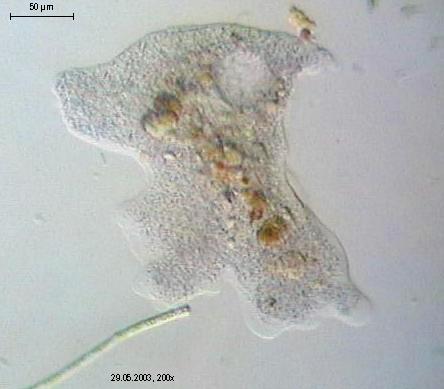- Amoebozoa
Taxobox
fossil_range =Neoproterozoic Dubious|date=March 2008 -Recent

image_width = 240px
image_caption = "Chaos diffluens"
domain =Eukaryota
regnum =Amoebozoa
regnum_authority =Lühe , 1913 "emend."
subdivision_ranks = Subgroups
subdivision = Mycetozoa (slime molds)Archamoebae Tubulinea Flabellinea
Uncertain placement
Acanthopodida
Stereomyxida
etc.The Amoebozoa are a major group ofamoeboid protozoa, including the majority that move by means of internalcytoplasm ic flow. Theirpseudopod ia are characteristically blunt and finger-like, called lobopodia. Most are unicellular, and are common in soils and aquatic habitats, with some found as symbiotes of other organisms, including several pathogens. The Amoebozoa also include theslime mould s,multinucleate or multicellular forms that produce spores and are usually visible to the unaided eye.Amoebozoa vary greatly in size. Many are only 10-20 μm in size, but they also include many of the larger protozoa. The famous species "Amoeba proteus" may reach 800 μm in length, and partly on account of its size is often studied as a representative cell. Multinucleate amoebae like "Chaos" and "
Pelomyxa " may be several millimetres in length, and some slime moulds cover several square feet.Morphology
The cell is typically divided into a granular central mass, called endoplasm, and a clear outer layer, called ectoplasm. During locomotion the endoplasm flows forwards and the ectoplasm runs backwards along the outside of the cell. Many amoeba move with a definite anterior and posterior; in essence the cell functions as a single pseudopod. They usually produce numerous clear projections called subpseudopodia (or determinate pseudopodia), which have a defined length and are not directly involved in locomotion.
Other amoebozoans may form multiple indeterminate pseudopodia, which are more or less tubular and are mostly filled with granular endoplasm. The cell mass flows into a leading pseudopod, and the others ultimately retract unless it changes direction. Subpseudopodia are usually absent. In addition to a few naked forms like "Amoeba" and "Chaos", this includes most amoebae that produce shells. These may be composed of organic materials, as in "
Arcella ", or of collected particles cemented together, as in "Difflugia ", with a single opening through which the pseudopodia emerge.The primary mode of nutrition is by
phagocytosis : the cell surrounds potential food particles, sealing them intovacuole s where the may be digested and absorbed. Some amoebae have a posterior bulb called a uroid, which may serve to accumulate waste, periodically detaching from the rest of the cell. When food is scarce, most species can formcyst s, which may be carried aerially and introduce them to new environments. In slime moulds, these structures are called spores, and form on stalked structures called fruiting bodies or sporangia.Most Amoebozoa lack flagella and more generally do not form
microtubule -supported structures except duringmitosis . However, flagella occur among somearchamoebae , and many slime moulds produce biflagellategamete s. The flagella is generally anchored by a cone of microtubules, suggesting a close relationship to theopisthokont s. The mitochondria characteristically have branching tubularcrista e, but have been lost among archamoebae.Classification
Traditionally all amoebae with lobose pseudopods were treated together as the
Lobosea , placed with other amoeboids in the phylum Sarcodina orRhizopoda , but these were considered to be unnatural groups. Structural and genetic studies identified thepercolozoa ns and several archamoebae as independent groups. In phylogenies based onrRNA their representatives were separate from other amoebae, and appeared to diverge near the base of eukaryotic evolution, as did most slime molds.However, revised trees by Cavalier-Smith and Chao in 1996 [cite journal | author=Cavalier-Smith, T. & Chao, E.E.
title = Molecular phylogeny of the free-living archezoan "Trepomonas agilis" and the nature of the first eukaryote
journal = Journal of Molecular Evolution
year = 1996 | volume = 43 | pages = 551–562 | doi=10.1007/BF02202103] suggested that the remaining lobosans do form a monophyletic group, and that the archamoebae and Mycetozoa are closely related to it, although the percolozoans are not. Subsequently they emended the older phylum Amoebozoa to refer to this supergroup. [cite journal | author=Cavalier-Smith, T.
title = A revised six-kingdom system of life
journal = Biological Reviews of the Cambridge Philosophical Society
year = 1998 | volume = 73 | pages = 203–266
doi = 10.1017/S0006323198005167] Studies based on other genes have provided strong support for the unity of this group. [cite journal | author = Baldauf, S.L. "et al".
title = A kingdom-level phylogeny of eukaryotes based on combined protein data
journal = Science
year = 2000 | volume = 290 | pages = 972–977
doi = 10.1126/science.290.5493.972
pmid = 11062127] Patterson treated most with the testate filose amoebae as the ramicristates [cite journal | author = David J. Patterson
title = The Diversity of Eukaryotes
journal = American Naturalist
year = 1999 | volume = 145 | pages = S96–S124] , based on mitochondrial similarities, but the latter are now removed to theCercozoa .Amoebae are difficult to classify, and relationships within the phylum remain confused. Originally the archamoebae and Mycetozoa were placed in a subphylum Conosa, which receives some support from molecular phylogenies, and the others were placed in a subphylum Lobosa, which is paraphyletic. Two major classes of Lobosa have been identified, the
Tubulinea andFlabellinea , but various others remain of uncertain placement.On a broader scale, it appears (based in proteomes) that the amoebozoa form a
stem group to animals and fungi, diverging from this lineage after it had split from the plants,cite journal
author = Eichinger, L.
coauthors = Pachebat, J.A.; Glöckner, G.; Rajandream, M.A.; Sucgang, R.; Berriman, M.; Song, J.; Olsen, R.; Szafranski, K.; Xu, Q.; Others,
year = 2005
title = The genome of the social amoeba "Dictyostelium discoideum"
journal = Nature
volume = 435
issue = 7038
pages = 43–57
doi = 10.1038/nature03481] as illustrated below:Strong similarities between Amoebozoa and
Opisthokont s (including animals and fungi) lead to the proposal that they form a clade calledUnikont s.List of amoeboid protozoa pathogenic to humans
*"
Entamoeba histolytica "
*"Acanthamoeba "
*"Balamuthia mandrillaris "References
External links
* [http://www.unige.ch/sciences/biologie/biani/msg/Amoeboids/Amoebozoa.html Molecular Phylogeny of Amoeboid Protists - Tree of Amoebozoa]
* [http://www.bairbrepaws.com/psneeley/FwrPLA.htm Joseph Leidy's Amoeba Plates]
Wikimedia Foundation. 2010.
